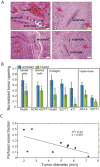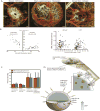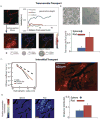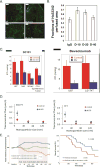Reengineering the Physical Microenvironment of Tumors to Improve Drug Delivery and Efficacy: From Mathematical Modeling to Bench to Bedside
- PMID: 29606314
- PMCID: PMC5930008
- DOI: 10.1016/j.trecan.2018.02.005
Reengineering the Physical Microenvironment of Tumors to Improve Drug Delivery and Efficacy: From Mathematical Modeling to Bench to Bedside
Abstract
Physical forces have a crucial role in tumor progression and cancer treatment. The application of principles of engineering and physical sciences to oncology has provided powerful insights into the mechanisms by which these forces affect tumor progression and confer resistance to delivery and efficacy of molecular, nano-, cellular, and immuno-medicines. Here, we discuss the mechanics of the solid and fluid components of a tumor, with a focus on how they impede the transport of therapeutic agents and create an abnormal tumor microenvironment (TME) that fuels tumor progression and treatment resistance. We also present strategies to reengineer the TME by normalizing the tumor vasculature and the extracellular matrix (ECM) to improve cancer treatment. Finally, we summarize various mathematical models that have provided insights into the physical barriers to cancer treatment and revealed new strategies to overcome these barriers.
Copyright © 2018 Elsevier Inc. All rights reserved.
Figures









Similar articles
-
Reengineering the Tumor Vasculature: Improving Drug Delivery and Efficacy.Trends Cancer. 2018 Apr;4(4):258-259. doi: 10.1016/j.trecan.2018.02.010. Epub 2018 Mar 17. Trends Cancer. 2018. PMID: 29606306 Free PMC article. Review.
-
Targeting Biophysical Cues: a Niche Approach to Study, Diagnose, and Treat Cancer.Trends Cancer. 2018 Apr;4(4):268-271. doi: 10.1016/j.trecan.2018.02.006. Epub 2018 Mar 12. Trends Cancer. 2018. PMID: 29606309 Free PMC article. Review.
-
Physical oncology: New targets for nanomedicine.Biomaterials. 2018 Jan;150:87-99. doi: 10.1016/j.biomaterials.2017.10.014. Epub 2017 Oct 6. Biomaterials. 2018. PMID: 29035739 Review.
-
Taking a Full Snapshot of Cancer Biology: Deciphering the Tumor Microenvironment for Effective Cancer Therapy in the Oncology Clinic.OMICS. 2020 Apr;24(4):175-179. doi: 10.1089/omi.2020.0019. Epub 2020 Mar 13. OMICS. 2020. PMID: 32176591 Review.
-
Tumor microenvironment remodeling-based penetration strategies to amplify nanodrug accessibility to tumor parenchyma.Adv Drug Deliv Rev. 2021 May;172:80-103. doi: 10.1016/j.addr.2021.02.019. Epub 2021 Mar 9. Adv Drug Deliv Rev. 2021. PMID: 33705874 Review.
Cited by
-
Challenges of applying multicellular tumor spheroids in preclinical phase.Cancer Cell Int. 2021 Mar 4;21(1):152. doi: 10.1186/s12935-021-01853-8. Cancer Cell Int. 2021. PMID: 33663530 Free PMC article. Review.
-
Long-Term Tumor Control Following Targeted Alpha Therapy (TAT) of Low-Grade Gliomas (LGGs): A New Treatment Paradigm?Int J Mol Sci. 2023 Oct 28;24(21):15701. doi: 10.3390/ijms242115701. Int J Mol Sci. 2023. PMID: 37958683 Free PMC article.
-
Safety and efficacy of lenvatinib combined with camrelizumab plus transcatheter arterial chemoembolization for unresectable hepatocellular carcinoma: A two-center retrospective study.Front Oncol. 2022 Sep 12;12:982948. doi: 10.3389/fonc.2022.982948. eCollection 2022. Front Oncol. 2022. PMID: 36172158 Free PMC article.
-
Mathematical modeling of intratumoral immunotherapy yields strategies to improve the treatment outcomes.PLoS Comput Biol. 2023 Dec 19;19(12):e1011740. doi: 10.1371/journal.pcbi.1011740. eCollection 2023 Dec. PLoS Comput Biol. 2023. PMID: 38113269 Free PMC article.
-
Extracellular matrix physical properties govern the diffusion of nanoparticles in tumor microenvironment.Proc Natl Acad Sci U S A. 2023 Jan 3;120(1):e2209260120. doi: 10.1073/pnas.2209260120. Epub 2022 Dec 27. Proc Natl Acad Sci U S A. 2023. PMID: 36574668 Free PMC article.
References
-
- Carmeliet P, Jain RK. Angiogenesis in cancer and other diseases. Nature. 2000;407(6801):249–257. - PubMed
-
- Jain RK, et al. Angiogenesis in brain tumours. Nature Reviews Neuroscience. 2007;8(8):610–622. - PubMed
-
- Gazit Y, et al. Fractal characteristics of tumor vascular architecture during tumor growth and regression. Microcirculation. 1997;4(4):395–402. - PubMed
Publication types
MeSH terms
Substances
Grants and funding
- R01 CA126642/CA/NCI NIH HHS/United States
- U01 CA224348/CA/NCI NIH HHS/United States
- 336839/ERC_/European Research Council/International
- R01 CA098706/CA/NCI NIH HHS/United States
- R01 CA085140/CA/NCI NIH HHS/United States
- R01 CA129371/CA/NCI NIH HHS/United States
- R35 CA197743/CA/NCI NIH HHS/United States
- R01 CA204949/CA/NCI NIH HHS/United States
- P01 CA080124/CA/NCI NIH HHS/United States
- R01 CA208205/CA/NCI NIH HHS/United States
- R01 HL128168/HL/NHLBI NIH HHS/United States
- R01 CA115767/CA/NCI NIH HHS/United States
- R01 CA096915/CA/NCI NIH HHS/United States
- P50 CA165962/CA/NCI NIH HHS/United States
LinkOut - more resources
Full Text Sources
Other Literature Sources

